[Ebook] Indoor Gardening Houseplants 2016 USA Magazine 2016 USA, Indoor Gardening Houseplants Magazine
[Ebook] Indoor Gardening Houseplants 2016 USA Magazine – XIII – Starting Seeds (Bắt đầu bằng hạt)
- Dịch: Huyền Nguyễn
ENGLISH
- WRITERS: CARRIE BEBRIS AND KATE CARTER FREDERICK
- PHOTOGRAPHER: PETE KRUMHARDT
THE TECHNIQUES AND MATERIALS INVOLVED IN STARTING PLANTS FROM SEEDS ARE FEW, BUT THE REWARDS FOR GARDENERS ARE GREAT.
Planting seeds indoors has practical benefits: saving money, getting a head start on the growing season, and selecting from varieties more diverse than those available at your local garden center. There are also the seemingly magical benefits of the joy and wonder that come with watching an innocuous seed sprout into a living plant. You will be so amazed and proud!
Knowing that your garden plants can be grown from seeds or seedlings (transplants), think ahead. When the outdoor world remains wintry, start vegetables, herbs, and flowers from seeds indoors, and be alert in spring to favorable conditions to sow them directly in the garden.
When purchasing seeds, check packets for freshness dates and choose the best varieties for your garden and climate. It’s easy to get carried away and purchase too many seed packets. What’s more, a packet of seeds includes dozens—even hundreds—of potential plants and most likely more than you will need for this year’s garden. Buy only what you need and have room to raise, then save leftover seeds for next year or share them with friends and neighbors.
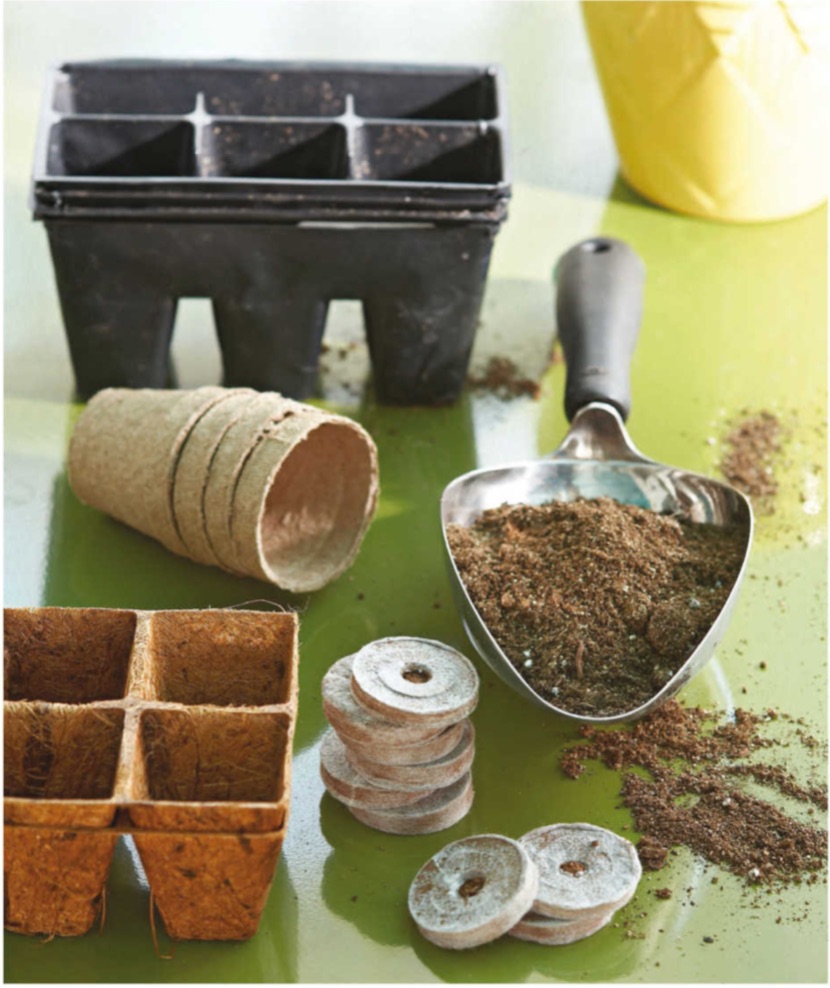
Germinating Seeds
Germination is a seed’s process of sprouting from a dormant plant embryo and growing into a wee plant. A seed stores the plant’s initial food supply within its protective coating. What a seed needs from the gardener is conducive conditions (moisture, temperature, air, and light) for growth.
To sprout seeds, you need only a few supplies. It is possible to start a few seeds on a very warm and sunny windowsill. Better yet, set up a nursery on a shelf or a tabletop where you can be messy with soil and water, and there is access to electricity. Basic materials for a nursery include containers, soilless seed-starting mix, fluorescent light, heat mat, and timer for the light. A basic, inexpensive setup of equipment lasts for many years.
Start with clean containers that allow excess moisture to drain away. Plastic trays are sold in kits with planting packs and covers; the packs vary in size and number of cells for transplant-size seedlings. Some gardeners reuse plastic nursery containers, including flats, packs, and pots of various sizes. Others repurpose containers, such as yogurt cups and other recyclable plastic packaging. Wash containers in hot soapy water and disinfect with a weak bleach solution before filling with soilless mix.
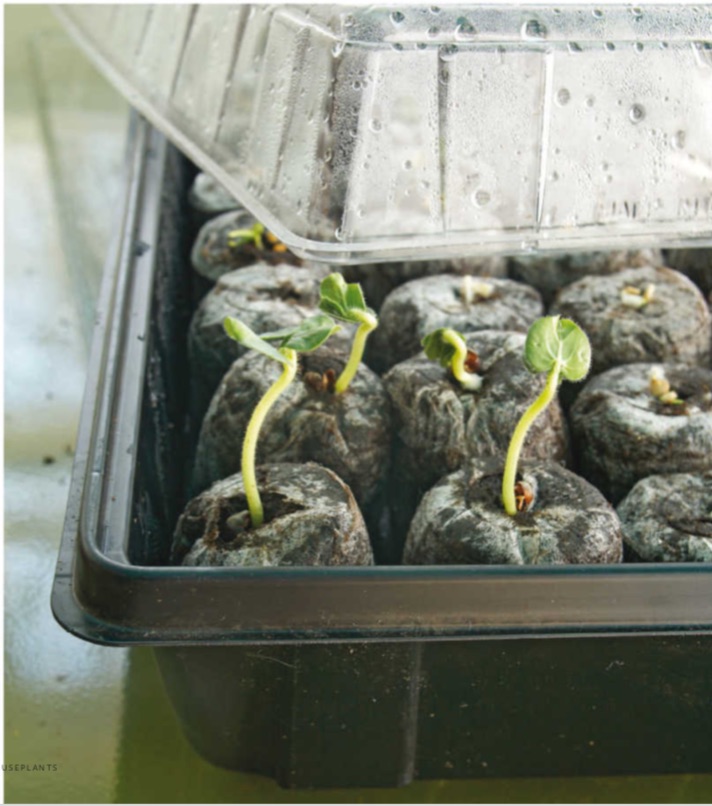
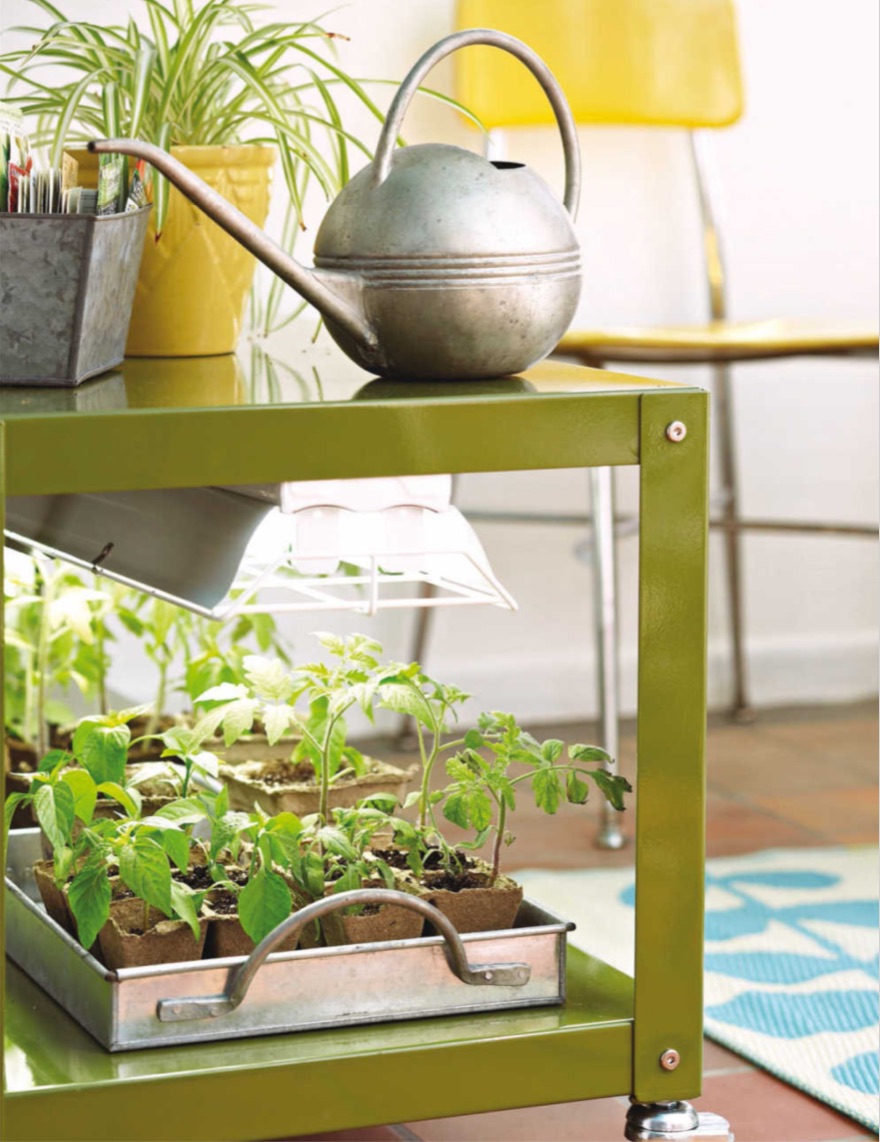
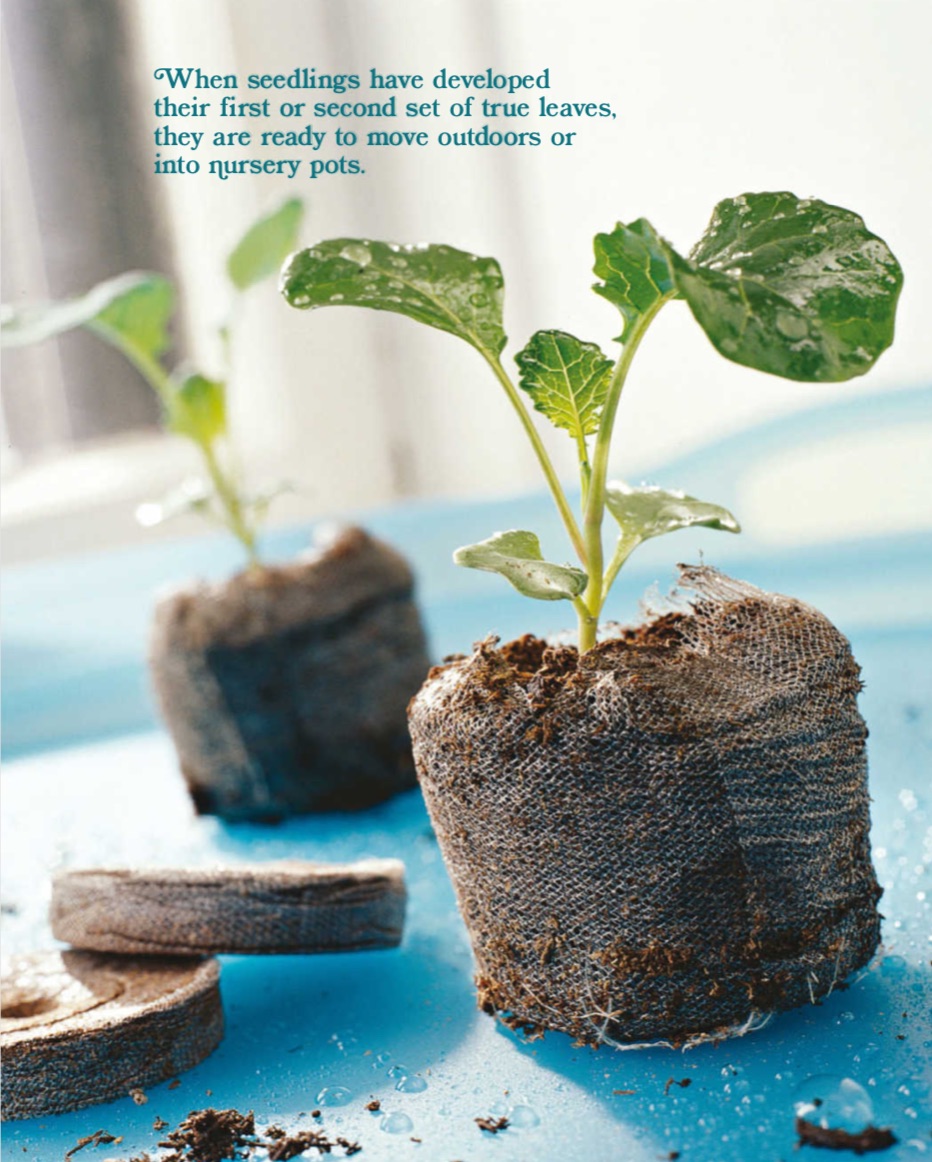
Leaving the n?est
As seedlings develop their first set of true leaves (after the initial seed leaves), the containers will become crowded and you will need to thin out the weakest seedlings. It’s hard to get rid of healthy plants, but if you let the crowding continue, all the plants will suffer and fail to thrive. Keep the largest, healthiest seedlings and pull out weak plants or cut them at soil level. Transplant extraneous healthy seedlings into other containers.
Leave at least an inch of space between the remaining seedlings or grow one seedling per container. As the survivors grow and outdoor temperatures reach the 50s°F and above, the seedlings are ready to “harden off” (get tough) by being set in a protected area outdoors, such as a entryway or porch, sheltered from sun and wind. After a few days, they’re ready for their move to the garden.
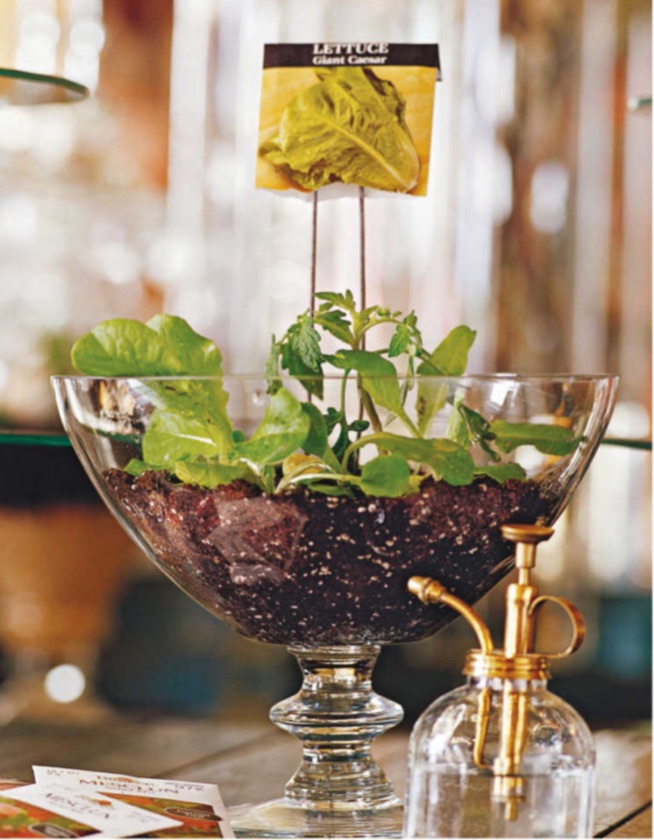
TIẾNG VIỆT
- TÁC GIẢ: CARRIE BEBRIS VÀ KATE CARTER FREDERICK
- ẢNH: PETE KRUMHARDT
CẦN ÍT KỸ THUẬT VÀ VẬT LIỆU ĐỂ TRỒNG CÂY TỪ HẠT GIỐNG NHƯNG PHẦN THƯỞNG CHO NGƯỜI LÀM VƯỜN LẠI VÔ CÙNG TUYỆT VỜI.
Trồng hạt giống trong nhà có những lợi ích thiết thực: tiết kiệm tiền, bắt đầu thuận lợi vào mùa trồng trọt và lựa chọn từ các loại giống đa dạng hơn những giống có sẵn tại trung tâm vườn địa phương. Ngoài ra bạn sẽ rất ngạc nhiên và tự hào khi chứng kiến một hạt giống nảy mầm thành một cây sống.
Dù biết rằng cây trong vườn của bạn có thể được trồng từ hạt hoặc cây con (cấy ghép), bạn hãy suy nghĩ trước. Khi thời tiết ngoài trời vẫn còn lạnh giá, hãy bắt đầu trồng rau, thảo mộc và hoa từ hạt giống trong nhà, và chú ý khi điều kiện thời tiết thuận lợi vào mùa xuân để gieo trực tiếp trong vườn.
Khi mua hạt giống, hãy kiểm tra các gói để biết thời gian cây nảy mầm và chọn những giống tốt nhất cho khu vườn và khí hậu nơi bạn sinh sống. Thật dễ dàng để mang đi và mua nhiều gói hạt giống. Hơn thế nữa, một gói hạt giống bao gồm hàng chục, thậm chí hàng trăm các loại cây tiềm năng và rất có thể số hạn giống sẽ nhiều hơn những gì bạn cần để trồng trong khu vườn năm nay. Chỉ mua lượng hạt giống bạn cần và có chỗ để trồng, sau đó để dành số hạt giống còn lại cho năm sau hoặc chia sẻ chúng với bạn bè và hàng xóm.

Hạt nảy mầm
Nảy mầm là quá trình hạt nảy mầm từ phôi thực vật ngủ đông và phát triển thành cây con. Hạt giống lưu trữ nguồn dinh dưỡng ban đầu của cây trong lớp phủ bảo vệ của nó. Người làm vườn cần cung cấp cho hạt giống các điều kiện thuận lợi về độ ẩm, nhiệt độ, không khí và ánh sáng để phát triển.
Để hạt nảy mầm, bạn chỉ cần thực hiện một vài bước. Có thể gieo một vài hạt giống trên bệ cửa sổ thật ấm áp và đầy nắng. Tốt hơn hết, bạn hãy bố trí vườn ươm trên giá hoặc mặt bàn, nơi bạn có thể thoải mái xáo đất và tưới nước mà không lo làm bẩn bề mặt, nơi có đường điện. Vật liệu cơ bản cho một vườn ươm bao gồm chậu, hỗn hợp gieo hạt không cần đất, đèn huỳnh quang, thảm nhiệt và bộ hẹn giờ đón ánh sáng. Đó là một số thiết bị cơ bản, không tốn kém và sẽ được dùng kéo dài trong nhiều năm.
Bắt đầu với các chậu cây sạch sẽ có khả năng thoát hơi ẩm dư thừa. Khay nhựa được bán trong bộ dụng cụ với gói hạt giống và nắp trồng; các gói khác nhau về kích thước và số lượng hạt giống. Một số người làm vườn tái sử dụng các thùng ươm bằng nhựa, bao gồm các thùng, bao bì và chậu với nhiều kích cỡ khác nhau. Những người khác sử dụng lại các hộp đựng, chẳng hạn như cốc đựng sữa chua và bao bì nhựa có thể tái chế khác. Rửa chậu ươm trong nước xà phòng nóng và khử trùng bằng dung dịch tẩy yếu trước khi đổ đầy hỗn hợp không chứa chất.



Chuyển cây con ra ngoài trời hoặc vào bầu ươm
Khi cây con phát triển bộ lá thật đầu tiên (sau khi mất hạt ban đầu), các thùng chứa sẽ trở nên chật chội và bạn sẽ cần tỉa bớt những cây con yếu nhất. Thật khó để loại bỏ những cây khỏe mạnh, nhưng nếu bạn cứ để một số lượng lớn cây con cùng phát triển, tất cả các cây sẽ bị ảnh hưởng và không phát triển được. Giữ những cây con lớn nhất, khỏe mạnh nhất và nhổ những cây yếu hoặc cắt ngang mặt đất. Cấy các cây con khỏe mạnh vào các chậu cây khác.
Để lại khoảng trống ít nhất một inch giữa các cây con còn lại hoặc trồng một cây con trên mỗi thùng. Khi những cây này phát triển và nhiệt độ ngoài trời đạt từ 10 độ C (50 °F) trở lên, cây con đã cứng cáp và sẵn sàng để được đặt trong khu vực được bảo vệ ngoài trời, chẳng hạn như lối vào hoặc hiên nhà, được che chắn khỏi nắng và gió. Sau một vài ngày, chúng đã sẵn sàng để chuyển đến khu vườn.


![[Ebook] Indoor Gardening Houseplants 2016 USA Magazine – XIII – Starting Seeds (Bắt đầu bằng hạt) [Ebook] Indoor Gardening Houseplants 2016 USA Magazine – XIII – Starting Seeds (Bắt đầu bằng hạt)](https://vn1.vdrive.vn/codai.net/2021/02/ebook-indoor-gardening-houseplants-2016-usa-xiii-starting-seeds-01.jpg)


